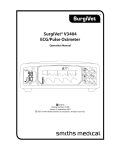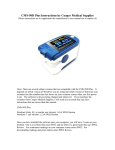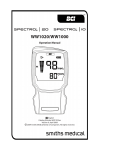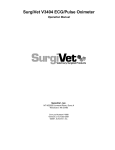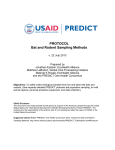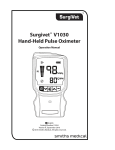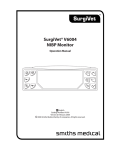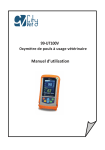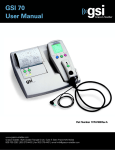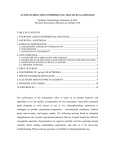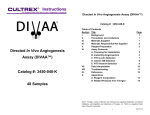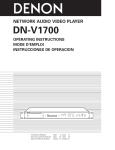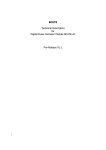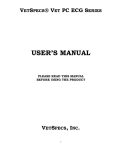Download Pulse Oxymeter Oxyvet Digital
Transcript
Table of Contents Table of Contents Warranty and Service Information...................................................................... v Proprietary Notice.......................................................................................................................................................v Warranty.........................................................................................................................................................................v Limited Warranty.................................................................................................................................................v Loaner Device (Domestic Sales Only)..........................................................................................................v Disclaimer of Warranties..................................................................................................................................vi Conditions of Warranty....................................................................................................................................vi Limitation of Remedies....................................................................................................................................vi Warranty Procedure..........................................................................................................................................vi CE Notice......................................................................................................................................................................vii Chapter 1: Introduction....................................................................................1-1 About this Manual...................................................................................................................................................1-1 Definition of Symbols............................................................................................................................................1-1 Warnings.....................................................................................................................................................................1-2 Cautions......................................................................................................................................................................1-5 Notes............................................................................................................................................................................1-5 Chapter 2: Intended Use and General Information........................................2-1 Intended Use.............................................................................................................................................................2-1 Monitor Features.....................................................................................................................................................2-1 Theory of Operation...............................................................................................................................................2-2 Patented Technology.............................................................................................................................................2-3 Chapter 3: Controls and Features....................................................................3-1 Monitor Front Panel . .............................................................................................................................................3-1 Monitor Operating Keys........................................................................................................................................3-3 Chapter 4: Operating Instructions..................................................................4-1 Unpacking the Monitor.........................................................................................................................................4-1 Install the Batteries.................................................................................................................................................4-1 AC Power....................................................................................................................................................................4-1 Attaching the Sensor to the Patient.................................................................................................................4-2 Choosing the Sensor..............................................................................................................................................4-2 Care and Handling of the Sensor.......................................................................................................................4-3 Pulse Oximeter Sensors.........................................................................................................................................4-4 Reflectance Sensors................................................................................................................................................4-4 Pulse Oximeter Sensor Application Tips ........................................................................................................4-5 Testing Sensor Function........................................................................................................................................4-5 Primary Applications for Sensors.......................................................................................................................4-5 Large and Mini ‘Y’ Sensor and Mini Clip Sensor...................................................................................4-5 C Sensor..............................................................................................................................................................4-5 Tail Wrap Sensor and Reflectance Sensor..............................................................................................4-6 Handheld Digital Pulse Oximeter Operation Manual Table of Contents Limitations.................................................................................................................................................................4-6 Checking the Sensor and Oximetry Cable.....................................................................................................4-6 Cleaning or Disinfecting the Sensors...............................................................................................................4-7 Turning On the Monitor........................................................................................................................................4-7 High Priority Alarms...............................................................................................................................................4-8 Low Priority Alarms.................................................................................................................................................4-9 Low Battery Indicator.......................................................................................................................................... 4-10 High and Low Priority Alarm Summary........................................................................................................ 4-11 Turning Off the Monitor..................................................................................................................................... 4-11 Checking the Monitor’s Performance........................................................................................................... 4-11 Chapter 5: Changing the Monitor’s Settings..................................................5-1 Silencing Alarm Tones............................................................................................................................................5-1 Changing the Pulse Beep Volume.....................................................................................................................5-1 Changing the Alarm Limits..................................................................................................................................5-1 Setup Mode...............................................................................................................................................................5-2 Alarm Volume...........................................................................................................................................................5-2 Low Priority Alarms Delay....................................................................................................................................5-3 Permanent Silence Disable..................................................................................................................................5-3 Chapter 6: Patient Numbers and Trend Data..................................................6-1 Description ...............................................................................................................................................................6-1 Incrementing the Patient Number....................................................................................................................6-1 Adjusting the Trend Storage Interval...............................................................................................................6-1 Clearing Trend Data................................................................................................................................................6-1 Chapter 7: Printer.............................................................................................7-1 Description................................................................................................................................................................7-1 What You’ll Need for Printing..............................................................................................................................7-1 Trend Printouts.........................................................................................................................................................7-2 Collecting Trend Data....................................................................................................................................7-2 Data log.......................................................................................................................................................................7-2 Chapter 8: PC Communication Setup..............................................................8-1 Description................................................................................................................................................................8-1 PC Communication Setup....................................................................................................................................8-1 Chapter 9: Maintenance...................................................................................9-1 Schedule of Maintenance.....................................................................................................................................9-1 Storage........................................................................................................................................................................9-1 Chapter 10: Troubleshooting.........................................................................10-1 EMI Interference.................................................................................................................................................... 10-2 Chapter 11: Optional Supplies and Accessories...........................................11-1 Ordering Information.......................................................................................................................................... 11-1 ii Handheld Digital Pulse Oximeter Operation Manual Chapter 1: Introduction Chapter 1: Introduction About this Manual The Operation Manual provides installation, operation, and maintenance instructions for veterinary health-care professionals and other users, trained in monitoring respiratory and veterinary activity. These instructions contain important information for the safe use of the product. Read the entire contents of these Instructions For Use, including Warnings and Cautions, before using the monitor. Failure to properly follow warnings, cautions and instructions could result in death or serious injury to the patient. Definition of Symbols symbol definition p Type CF Equipment. g Attention, see instructions for use. 7 Refer servicing to qualified service personnel. Z Alarm Select E F G B x 1 Input voltage no Printer On/Off Direct Current Alarm silence On/Off Non AP device Up and Down Arrows k j z Alarm LED M X Low Battery LED p y C IPX1 %SpO2 K 6 Alarm Silenced LED Artifact LED External power/Battery eliminator Heart Rate LED Date of Manufacture Use by Drip Proof (monitor only) Percent Oxygen Saturation Moisture sensitive Caution: Federal (U.S.A.) law restricts this device to sale by or on the order of a Licensed Veterinarian. Veterinary Handheld Digital Pulse Oximeter Operation Manual 1-1 Chapter 1: Introduction Z Collect Separately Y Disposal (EU Countries) Under the Waste Electrical and Electronic Equipment (WEEE) Directive 2006/96/EC and implementing regulations, all devices and service items within the scope of the Directive purchased new after August 13, 2005 must be sent for recycling when ultimately becoming waste. Devices and items must not be disposed of with general waste. If purchased before that date, they may also be sent for recycling if being replaced on a one-for-one, like-for-like basis (this varies depending on the country). Recycling instructions to customers using Smiths Medical products are published on the internet at: http://www.smiths-medical.com/recycle Disposal (other countries) When disposing of this device, its batteries or any of its accessories, ensure that any negative impact on the environment is minimized. Contact your local waste disposal service and use local recycling or disposal schemes. Separate any other parts of the equipment where arrangements can be made for their recovery; either by recycling or energy recovery. The main batteries are potentially harmful and will require separate disposal according to manufacturer’s instructions or local regulations. Note: If applicable, EU, national or local regulations concerning waste disposal must take precedence over the above advice. keyword definition warning Tells you something that could hurt the patient or hurt the operator. caution Tells you something that could damage the device. note Tells you other important information. Warnings WARNING! Do not use this device in the presence of flammable anesthetics. WARNING! Do not use this device in the presence of magnetic resonance imaging (MR or MRI) equipment. WARNING! Use only SpO2 sensors supplied with, or specifically intended for use with, this device. WARNING! Do not plug the monitor into an outlet controlled by a wall switch. WARNING! This device is intended for use by persons trained in professional health care. The operator must be thoroughly familiar with the information in this manual before using the device. WARNING! This device must be used in conjunction with clinical signs and symptoms. This device is only intended to be an adjunct in patient assessment. WARNING! It is the operator’s responsibility to set alarm limits appropriately for each individual patient. WARNING! Prolonged use or the patient’s condition may require changing the sensor site periodically. Change sensor site and check skin integrity, circulatory status, and correct alignment at least every 4 hours. WARNING! ELECTRICAL SHOCK HAZARD when cover is removed. Do not remove covers. Refer servicing to qualified personnel. 1-2 Veterinary Handheld Digital Pulse Oximeter Operation Manual Chapter 1: Introduction WARNING! In the event that earth ground integrity is lost, the performance of this device and/or other devices nearby may be affected due to excessive RF emissions. WARNING! Any monitor that has been dropped or damaged should be inspected by qualified service personnel, prior to use, to insure proper operation. WARNING! If the accuracy of any measurement is in question, verify the patient’s vital sign(s) by an alternative method and then check the monitor for proper functioning. WARNING! Remove device batteries prior to long term storage. WARNING! When attaching sensors with Microfoam® tape, do not stretch the tape or attach the tape too tightly. Tape applied too tightly may cause inaccurate readings and blisters on the patient’s skin (lack of skin respiration, not heat, causes the blisters). WARNING! Operation of this device may be adversely affected in the presence of strong electromagnetic sources, such as electrosurgery equipment. WARNING! Operation of this device may be adversely affected in the presence of computed tomograph (CT) equipment. WARNING! Use only SpO2 sensors supplied with, or specifically intended for use with, this device. WARNING! SpO2 measurements may be adversely affected in the presence of high ambient light. Shield the sensor area (with a surgical towel, for example) if necessary. WARNING! Dyes introduced into the bloodstream, such as methylene blue, indocyanine green, indigo carmine, patent blue V (PBV), and fluorescein may adversely affect the accuracy of the SpO2 reading. WARNING! Any condition that restricts blood flow, such as use of a blood pressure cuff or extremes in systemic vascular resistance, may cause an inability to determine accurate pulse rate and SpO2 readings. WARNING! Significant levels of dysfunctional hemoglobins, such as carboxyhemoglobin or methemoglobin, will affect the accuracy of the SpO2 measurement. WARNING! The monitor was not designed or tested to be an apnea monitor. WARNING! Optical cross-talk can occur when two or more sensors are placed in close proximity. It can be eliminated by covering each site with an opaque material. WARNING! Tissue damage may result from overexposure to sensor light during photodynamic therapy with agents such as verteporphin, porfimer sodium, and metatetrahydroxyphenylchlorin (mTHPC). Change the sensor site at least every hour and observe for signs of tissue damage. More frequent sensor site changes/inspections may be indicated depending upon the photodynamic agent used, agent dose, skin condition, total exposure time or other factors. Use multiple sensor sites. Veterinary Handheld Digital Pulse Oximeter Operation Manual 1-3 Chapter 1: Introduction WARNING! When connecting this monitor to any instrument, verify proper operation before clinical use. Refer to the instrument’s user manual for full instructions. Accessory equipment connected to the monitor’s data interface must be certified according to the respective IEC standards, i.e., IEC 60950 for data processing equipment or IEC 601-1 for electromedical equipment. All combinations of equipment must be in compliance with IEC 601-1-1 systems requirements. Anyone connecting additional equipment to the signal input port or the signal output port configures a medical system, and, therefore, is responsible that the system complies with the requirements of the system standard IEC 601-1-1. WARNING! IEC 60950 approved equipment must be placed outside the “patient environment”. The patient environment is defined as an area 1.5 m (4.92 feet) from the patient. PATIENT ENVIRONMENT WARNING! Disconnect the AC power supply from the outlet before disconnecting it from the monitor. Leaving the AC power supply connected to an AC power outlet without being connected to the monitor may result in a safety hazard. WARNING! Do not allow any moisture to touch the AC power supply connectors or a safety hazard may result. Ensure that hands are thoroughly dry before handling the AC power supply. WARNING! Failure to place the monitor away from the patient may allow the patient to turn off, reset, or damage the monitor, possibly resulting in the patient not being monitored. WARNING! Failure to carefully route the cable from the sensor to the monitor may allow the patient to become entangled in the cable, possibly resulting in patient strangulation. Route the cable in a way that will prevent the patient from becoming entangled in the cable. If necessary, use tape to secure the cable. WARNING! If there is a risk of the AC power supply becoming disconnected from the monitor during use, secure the cord to the monitor several inches from the connection. WARNING! Under certain clinical conditions, pulse oximeters may display dashes if unable to display SpO2 and/or pulse rate values. Under these conditions, pulse oximeters may also display erroneous values. These conditions include, but are not limited to: patient motion, low perfusion, cardiac arrhythmias, high or low pulse rates or a combination of the above conditions. Failure of the clinician to recognize the effects of these conditions on pulse oximeter readings may result in patient injury. WARNING! Verify that all LEDs (light emitting diodes) on the display light up upon startup of the device. 1-4 Veterinary Handheld Digital Pulse Oximeter Operation Manual Chapter 1: Introduction Cautions CAUTION! Do not autoclave, ethylene oxide sterilize, or immerse the monitor or sensors in liquid. Always disconnect the power source and remove all batteries before cleaning or disinfecting the monitor. CAUTION! Should the device become wet, wipe off all moisture and allow sufficient time for drying before operating. CAUTION! The monitor should be operated from its internal power source if the integrity of the protective earth conductor is in doubt. CAUTION! Pressing front panel keys with sharp or pointed instruments may permanently damage the keypad. Press front panel keys only with your finger. CAUTION! Do not allow water or any other liquid to spill onto the monitor. Unplug the external power supply from the monitor before cleaning or disinfecting the monitor. Evidence that liquid has been allowed to enter the monitor voids the warranty. CAUTION! Ensure the device’s AC rating is correct for the AC voltage at your installation site before using the monitor. The monitor’s AC rating is shown on the external power supply. If the rating is not correct, do not use the monitor; contact the Smiths Medical PM, Inc. Clinical Support department, or your local distributor, for help. CAUTION! Connect only the printer/PC interface cable specifically intended for use with this device (see Optional Supplies and Accessories). CAUTION! Chemicals used in some cleaning agents may cause brittleness of plastic parts. Follow cleaning instructions in this manual. Notes NOTE! Batteries are user replaceable. Follow local governing ordinances and recycling instructions regarding disposal or recycling of device components, including batteries. NOTE! When using AC power, the Digital Oximeter is a class II device with functional earth. This earth connection is for device electromagnetic compatibility and does not provide protection to the patient or user. NOTE! It is recommended that batteries be used with the monitor when operating with AC power to prevent monitor shutdown with loss of AC power. NOTE! SpO2 averaging is the number of pulse beats over which the SpO2 value is averaged; pulse averaging is the number of seconds over which the pulse value is averaged. NOTE! All user and patient accessible materials are non-toxic. NOTE! Each input and output connection of the monitor is electrically isolated. NOTE! Performance and safety test data are available upon request. NOTE! To comply with government requirements for patient monitoring, the indefinite high priority alarm, medium priority alarm, and low priority alarm tone silence feature may not be available in monitors shipped to your country. Veterinary Handheld Digital Pulse Oximeter Operation Manual 1-5 Chapter 1: Introduction This page is intentionally left blank. 1-6 Veterinary Handheld Digital Pulse Oximeter Operation Manual Chapter 2: Intended Use and General Information Chapter 2: Intended Use and General Information Intended Use The Veterinary Handheld Digital Pulse Oximeter is a low cost monitor for spot checking or continuous monitoring of SpO2, pulse rate and pulse strength. The monitor is a battery powered pulse oximeter. It may be used in the hospital or clinical environment, and during emergency land transportation. The oximeter will operate accurately over an ambient temperature range of 32 to 131°F (0 to 55°C). The oximeter works with all SurgiVet® oximetry sensors providing SpO2 and pulse rate on all patients from neonatal to adult. This device is intended for continuous patient monitoring with adjustable alarm limits as well as visible and audible alarm signals. NOTE! The monitor was not designed or tested to be an apnea monitor. Monitor Features • Provides fast, reliable SpO2, pulse rate, and pulse strength measurements. • Ideally suited for use in intensive care units, outpatient clinics, emergency rooms, and during emergency land transport. • Portable and lightweight. Weighs only 454 grams (16 ounces), with batteries. • Ergonomically designed to fit comfortably in the palm of your hand. • Uses six (6) standard “AA” (type IEC LR6) alkaline batteries. • Battery life is approximately twenty-four (24) hours without printing. • Bright, easy-to-read LED displays indicate SpO2 and pulse rate measurements. • An eight-segment LED bar graph indicates pulse strength. • Adjustable volume (including silence) “beep” sounds with each pulse beat. Pitch of pulse “beep” corresponds to SpO2 value. • Positive identification of SpO2 or pulse rate alarm. Adjustable high and low alarm limits for SpO2 and pulse rate measurements. • Adjustable volume for alarm and alert tones (including silence). • User-adjustable delayed audible system alarms. • SpO2 and pulse rate averaging settings are user-selectable. • Artifact indicator informs user of excess motion and other artifacts. • User-adjustable trend storage rate, ranging from 4 to 30 seconds per sample, for many applications. • Low battery indicator lights when about 30 minutes of battery use remains. A yellow Low priority alarm LED turns on and an audible 5-beep burst notifies the user of low battery life. • Data log prints SpO2 and pulse rate readings in real time, once every five (5) seconds through the IR port to an optional printer. Veterinary Handheld Digital Pulse Oximeter Operation Manual 2-1 Chapter 2: Intended Use and General Information Theory of Operation The pulse oximeter determines %SpO2 and pulse rate by passing two wavelengths of low intensity light, one red and one infrared, through body tissue to a photodetector. Information about wavelength range can be especially useful to clinicians. Wavelength information for this device can be found in the SpO2 Specifications section of this manual. Pulse identification is accomplished by using plethysmographic techniques, and oxygen saturation measurements are determined using spectrophotometric oximetry principles. During measurement, the signal strength resulting from each light source depends on the color and thickness of the body tissue, the sensor placement, the intensity of the light sources, and the absorption of the arterial and venous blood (including the time varying effects of the pulse) in the body tissues. 1 2 Figure 2.1: Theory of Operation 1 Low intensity Red and Infrared LED light sources 2 Detector Oximetry processes these signals, separating the time invariant parameters (tissue thickness, skin color, light intensity, and venous blood) from the time variant parameters (arterial volume and SpO2) to identify the pulses and calculate functional oxygen saturation. Oxygen saturation calculations can be performed because blood saturated with oxygen predictably absorbs less red light than oxygen-depleted blood. WARNING! Since measurement of SpO2 depends on a pulsating vascular bed, any condition that restricts blood flow, such as the use of a blood pressure cuff or extremes in systemic vascular resistance, may cause an inability to determine accurate SpO2 and pulse rate readings. WARNING! Under certain clinical conditions, pulse oximeters may display dashes if unable to display SpO2 and/or pulse rate values. Under these conditions, pulse oximeters may also display erroneous values. These conditions include, but are not limited to: patient motion, low perfusion, cardiac arrhythmias, high or low pulse rates or a combination of the above conditions. Failure of the clinician to recognize the effects of these conditions on pulse oximeter readings may result in patient injury. 2-2 Veterinary Handheld Digital Pulse Oximeter Operation Manual Chapter 2: Intended Use and General Information Patented Technology The Handheld Digital Oximeter incorporates patented technology and noise reducing hardware to enhance the oximeter’s ability to detect pulse amplitude in patients with poor peripheral perfusion. Blood Pulse Detection Method Using Autocorrelation, patent number 5,558,096, analyzes a digitized signal, in real time, and compares it with previous pulse data. If similar characteristics to previous data are recognized, the device confirms a valid pulse. In essence, an individual’s pulse data is retained and used as a template to accept or reject future pulse signals. Patented technology, digital signal processing, and a greatly improved signal to noise ratio, provide for improved performance. Veterinary Handheld Digital Pulse Oximeter Operation Manual 2-3 Chapter 2: Intended Use and General Information This page is intentionally left blank. 2-4 Veterinary Handheld Digital Pulse Oximeter Operation Manual Chapter 3: Controls and Features Chapter 3: Controls and Features Monitor Front Panel 1 %SpO2 98 80 2 3 6 9 10 BPM k B 4 X n 5 SENSOR jz M 13 7 F 12 8 11 o Figure 3.1: Monitor Controls, and Features 1 Sensor/Printer Connector The sensor connects here, or an oximetry extension cable can be connected between the monitor and the sensor. The serial printer or PC communication cable is also connected here. 2 SpO2 Numeric Display A number shows the patient’s SpO2 value in percent. Dashes (--) mean the monitor is not able to calculate the SpO2 value. 3 Pulse Rate Numeric Display A number shows the patient’s pulse rate value in beats per minute. Dashes (--) mean the monitor is not able to calculate the pulse rate value. 4 Pulse Strength Bar Graph The pulse strength bar graph “sweeps” with the patient’s pulse beat. The height of the bar graph shows the patient’s pulse strength. 5 Sensor Problem Alert Indicator This indicator lights steadily to inform the operator of an oximeter sensor problem. 6 j Alarm Silence Indicator This indicator flashes during temporary two-minute alarm silence. The indictor lights steadily during permanent/indefinite alarm silence. 7 z Artifact Alert Indicator This indicator informs the operator about the presence of excess artifacts. 8 M Low Battery Indicator During a Low Battery Attention, this LED is lit and an audible burst of 5 beeps notifies the user that approximately 30 minutes of battery use remains. Veterinary Handheld Digital Pulse Oximeter Operation Manual 3-1 Chapter 3: Controls and Features 9 High Priority Alarm LED (red) This LED flashes twice every second during a high priority condition. This signal indicates that immediate operator attention is needed. 10 Low Priority Alarm LED (yellow) This LED indicates a low priority alarm, which lights steadily during a low priority alarm condition. 11 Line/Power Indicator (green) This LED lights steadily while external power is applied. 12 IR Printer Output The Digital Oximeter can transmit data to an optional HP printer via an infrared link through this port. 13 AC Power Jack An optional AC power supply connects here. 3-2 Veterinary Handheld Digital Pulse Oximeter Operation Manual Chapter 3: Controls and Features Monitor Operating Keys 98 80 BPM k B 3 5 SENSOR jz M F %SpO2 X n 4 o 2 1 Figure 3.2: Monitor Operating Keys 1 x ON/OFF Key Pressing this key turns the monitor ON and OFF. 2 n Up and o Down Arrows The Up and Down arrow keys are used to adjust the following settings: • Alarm Limits • %SpO2/Pulse Rate averaging • Trend Interval • Low Priority Alarms Delay • Alarm Volume • Pulse Volume 3 B Alarm Silence Momentarily pressing the Alarm Silence key disables the alarm tone for two (2) minutes. Pressing and holding the Alarm Silence key for about three (3) seconds disables the alarm tone indefinitely (until canceled or the monitor is turned off ). To cancel either the indefinite or the two-minute alarm and alert tone silenced condition, momentarily press the Alarm Silence key. The Alarm Silenced indicator will turn off. 4 H Alarm Select Pressing this key cycles through each of the alarm settings. 5 F PRINT/CLEAR Key Located on the side of the monitor. Pressing this key will send data to the optional IR printer. Pressing the key again will stop printing. Pressing and holding the Print/Clear key will clear the trend data. Veterinary Handheld Digital Pulse Oximeter Operation Manual 3-3 Chapter 3: Controls and Features This page is intentionally left blank. 3-4 Veterinary Handheld Digital Pulse Oximeter Operation Manual Chapter 4: Operating Instructions Chapter 4: Operating Instructions warning! This device must be used in conjunction with clinical signs and symptoms. This device is only intended to be an adjunct in patient assessment. Unpacking the Monitor 1. Carefully remove the monitor and its accessories from the shipping carton. Save the packing materials in case the monitor must be shipped or stored. 2. Compare the packing list with the supplies and equipment you received to make sure you have everything you’ll need. Install the Batteries The oximeter uses 6 (six) standard “AA” alkaline cells, IEC Type LR6. To install/replace the batteries: 1. Depress the battery door tab and lift up. 2. Install the negative end of each battery first, compressing the battery terminal spring until the positive terminal clears the positive tab. Press the battery down into place. 3. Place battery door tabs into the slots of the monitor back panel, depress the door tab, and press the door into place. NOTE! If you install disposable batteries, be sure to dispose of them in compliance with your institution’s guidelines and local ordinances. NOTE! The unit will hold data for about one and a half minutes with no battery power. This will insure the safety of trend data during battery replacement. AC Power Refer also to Chapter 12: Optional Supplies and Accessories to verify the proper AC power supply for your application. NOTE! The AC power supply does not act as a battery charger. NOTE! Do not plug the monitor into an outlet controlled by a wall switch. 1611 AC power supply 105 - 152 VAC 60Hz 1612 AC power supply 208 - 252 VAC 50/60Hz 1613 AC power supply 90 - 110 VAC 60Hz NOTE! When using AC power, the Digital Oximeter is a class II device with functional earth. This earth connection is for device electromagnetic compatibility and does not provide protection to the patient or user. NOTE! Intermittent use of AC power will require functional “AA” cells to maintain memory and keep the oximeter from defaulting to clinician mode from other modes. Veterinary Handheld Digital Pulse Oximeter Operation Manual 4-1 Chapter 4: Operating Instructions Attaching the Sensor to the Patient warning! Prolonged use or the patient’s condition may require changing the sensor site periodically. Change sensor site and check skin integrity, circulatory status, and correct alignment at least every 4 hours. warning! When attaching sensors with Microfoam® tape, do not stretch the tape or attach the tape too tightly. Tape applied too tightly may cause inaccurate readings and blisters on the patient’s skin (lack of skin respiration, not heat, causes the blisters). Attaching the patient to the monitor requires these steps: 1. Choose the sensor. 2. Check the sensor and oximetry cable. 3. Clean or disinfect the sensor if using the reusable type (Disposable sensors are for singlepatient use and do not require cleaning or disinfecting). 4. Attach the sensor to the patient. Choosing the Sensor Choose the appropriate sensor from the following chart. patient Small/Medium Animal up to 60 pounds Large Animals over 60 pounds Equine 4-2 site sensor #/Description Pinna (ears), Toe Webbing, Tongue V1711: Large ‘Y’ Sensor V1702: Mini ‘Y’ Sensor V3078: Mini Clip Sensor Rectum/Tail V1700: Reflectance Sensor V1710: Tail Wrap Sensor Hock, Achilles Tendon, etc. V1707: Universal ‘C’ Sensor Pinna (ears), Toe Webbing, Tongue V1711: Large ‘Y’ Sensor V1702: Mini ‘Y’ Sensor V3078: Mini Clip Sensor Rectum/Tail V1700: Reflectance Sensor V1710: Tail Wrap Sensor Hock, Achilles Tendon, etc. V1707: Universal ‘C’ Sensor Tongue V1707: Universal ‘C’ Sensor Veterinary Handheld Digital Pulse Oximeter Operation Manual Chapter 4: Operating Instructions Care and Handling of the Sensor warning! Misuse or improper handling of the sensor and cable could result in damage to the sensor. This may cause inaccurate readings. Hold the connector rather than the cable when connecting or disconnecting the sensor to the device as shown in Figure 4.1. Cable Connector %SpO2 SENSOR BPM k B j X n o Figure 4.1: Disconnecting or connecting the sensor. Do not use excessive force or unnecessary twisting when connecting, disconnecting, storing, or when using the sensor. Veterinary Handheld Digital Pulse Oximeter Operation Manual 4-3 Figure 4.2: Attaching the ‘Y’ sensor to the lingual clip Chapter 4: Operating Instructions Pulse Oximeter Sensors NOTE! 2 Please see insert accompanying each sensor for further details. Large ‘Y’ Sensor (V1711) Mini Clip (V3078) Mini ‘Y’ Sensor (V1702) Figure 4.2: Lingual Sensors Attach the sensor and clip to the patient’s tongue. Make sure the light source is topside of the tongue. Figure 4.3: Attaching the Sensor to the Animal Reflectance Sensors Tail Wrap Sensor (V1710) Figure 4.4: Reflectance Sensors Reflectance sensor (V1700) For best results while using the tail wrap sensor (V1710), apply to the ventral base of the tail with the divider positioned centrally. Moisten the fur and parting at the application site or shaving a small area is required. The sensor works best on medium to large sized patients. Secure sensor strap. Tail Clip Sensor Figure 4.5: Attaching the Sensor to the Animal For best results while using the reflectance sensor (V1700), apply to the base of the tail. This sensor can also be used rectally if needed. When using either of the reflectance sensors, ultrasound gel is recommended to enhance performance. Fur, dark pigmentation, poor perfusion and movement can affect the sensor’s ability to obtain accurate readings. 4-4 Veterinary Handheld Digital Pulse Oximeter Operation Manual Chapter 4: Operating Instructions Pulse Oximeter Sensor Application Tips There is some variation depending on the manufacturer, but there are three basic types of pulse oximeter sensors made for the small animal patient: • Large and Mini ‘Y’ sensors • Mini Clip sensor • ‘C’ sensor (may also be used on large animals) • Tail Wrap sensor • Reflectance sensor It is very important to have a variety of sensors in order to monitor the majority of the small animal patients. It is also important to select the proper sensor for animals based on their size, color, fur type, medical condition, and type of procedure. Testing Sensor Function 1. To test the large and mini ‘Y’ sensor functions, turn on the monitor with the lingual sensor attached. View the sensor to make sure a red light is being emitted, then place the sensor on a small finger (without nail polish). Rest the hand with the sensor on it on a table to minimize motion. Note that in most cases the red light should be shining in the same direction as the overhead or surgical lights. It is important that the light receptor is shielded in order to avoid interference from ambient light. Once placed on a patient site, the red light should be shining continuously. In some cases a blinking light indicates that the tissue thickness is either too thin or thick. Once the sensor is placed properly, both the SpO2 and pulse rate should appear in a short period of time (10-15 seconds). 2. Testing the ‘C’ sensor is performed in the same manner. This is a stronger sensor and can be used with greater tissue thickness. 3. Testing the tail wrap and reflectance sensors are performed in the same manner, but it should be pressed between thumb and index finger or into the palm of your hand. Primary Applications for Sensors Large and Mini ‘Y’ Sensor and Mini Clip Sensor • The primary application site is the tongue for most animals. On cats and small dogs, fold the tongue like a taco or use a wet gauze pad of single thickness folded over the tongue, and then place the sensor over the gauze. • Other sites include the prepuce or vulva of larger dogs, the achilles tendon of a cat or small dog, ears, or toe webbing. C Sensor • For cats and small breed dogs, place the sensor on the thigh, metatarsal or metacarpal, or hock near the saphenous vein. • For larger breed dogs, place the sensor over the Achilles tendon, tongue, prepuce or vulva, or through toe webbing. • It may be necessary to wet and part the fur with water in order to get the sensor closer to the skin of the patient. • For large animals (e.g. horses), place the sensor on the tongue. Veterinary Handheld Digital Pulse Oximeter Operation Manual 4-5 Chapter 4: Operating Instructions Tail Wrap Sensor and Reflectance Sensor • In most animals, wet and part the fur at the ventral tail base and use the straps on the tail wrap to hold the tail wrap sensor in place. • When using the reflectance sensor, wet and part the fur at the ventral tail base and use non-adhesive tape to hold the sensor in place. The reflectance sensor may be used rectally if the patient has a small or no tail. • It may be necessary to shave a small spot on the ventral tail base in patients with a thick undercoat, such as a Husky. Limitations Experience will quickly tell you which probes work best under different conditions. Fur, dark pigmentation, poor perfusion, and movement can all affect the sensors ability to obtain accurate readings. Well-perfused sites with little or no hair are preferable. It is also important to note that some anesthetic drugs, such as Xylazine (Rompun), Acepromazine, or Medetomidine (Domitor) can affect peripheral pulse pressures causing very weak pulsations. All pulse oximeters require a good quality pulse to work properly. Other drugs, such as ketamine, can cause the tongue to twitch, limiting the use of a lingual clip on that site. Checking the Sensor and Oximetry Cable Follow these instructions each time before you attach the sensor to the patient. This helps ensure the sensor and oximetry cable are working properly. warning! Using a damaged sensor may cause inaccurate readings. Inspect each sensor. If a sensor appears damaged, do not use it. Use another sensor or contact your authorized repair center for help. warning! Using a damaged oximetry cable may cause inaccurate readings. Inspect the oximetry cable. If the oximetry cable appears damaged, do not use it. Contact your authorized repair center for help. 1. Carefully inspect the sensor to make sure it does not appear damaged. 2. If using the oximetry cable, carefully inspect the oximetry cable to make sure it does not appear damaged. 3. If using the oximetry cable: a. If the sensor is not already connected to the oximetry cable, connect the sensor to the oximetry cable. Push the connectors together firmly and close the latch to secure the connectors. b. If the oximetry cable is not already connected to the monitor, connect the oximetry cable to the monitor. Push the connector firmly into the monitor. 4. If not using the oximetry cable, connect the sensor to the monitor. Push the connector firmly into the monitor. 5. If the monitor is not already on, press the x key to turn on the monitor. warning! If any of the integrity checks fail, do not attempt to monitor the patient. Use another sensor or oximetry cable, or contact the equipment dealer for help if necessary. 4-6 Veterinary Handheld Digital Pulse Oximeter Operation Manual Chapter 4: Operating Instructions 6. Before the sensor is attached to the patient, check the integrity of the sensor, oximetry cable, and oximeter as follows: a. Make sure the red light in the sensor is illuminated. NOTE! Obstructions or dirt on the sensor’s red light or detector may cause the checks to fail. Make sure there are no obstructions and the sensor is clean. 7. You are now ready to attach the sensor to the patient. Cleaning or Disinfecting the Sensors Clean or disinfect reusable sensors before attaching to a new patient. warning! Do not autoclave, ethylene oxide sterilize, or immerse the sensors in liquid. caution! Unplug the sensor from the monitor before cleaning or disinfecting. Clean the sensor with a soft cloth moistened in water or a mild soap solution. To disinfect the sensor, wipe the sensor with isopropyl alcohol. Turning On the Monitor %SpO2 98 80 1 2 3 BPM k B X n o Figure 4.6: SpO2, pulse rate, and pulse strength bar graph. 1 Patient’s SpO2 Shown Here 2 Patient’s Pulse Shown Here 3 Patient’s Pulse Strength Shown Here 1. To turn on the monitor, press the x key. When turned ON, the monitor does the following: • The top segment of the pulse strength bar graph illuminates. • The monitor's software revision is momentarily displayed. • The patient number is momentarily displayed. WARNING! Verify that all LEDs (light emitting diodes) on the display light up upon startup of the device. Veterinary Handheld Digital Pulse Oximeter Operation Manual 4-7 Chapter 4: Operating Instructions 2. The monitor has two averaging settings for %SpO2 and pulse rate. To change the averaging setting, press and hold the n Up Arrow while turning on the monitor. This will set the %SpO2 and pulse rate averaging to 16/16. Press and hold the o Down Arrow while turning on the monitor to set the %SpO2 and pulse rate averaging to 4/8. NOTE! Increasing or decreasing the averaging setting has no effect on the data update rate. NOTE! SpO2 averaging is the number of pulse beats over which the SpO2 value is averaged; pulse averaging is the number of seconds over which the pulse value is averaged. High Priority Alarms A high priority alarm warns you about an abnormal patient condition. A high priority alarm is activated when: • the patient’s SpO2 reading matches or exceeds the SpO2 alarm range. • the patient’s pulse rate reading matches or exceeds the pulse rate alarm range. %SpO2 98 20 1 BPM 2 k B X n o Figure 4.7: Alarm Example 1 During a high priority alarm, the numbers flash that correspond to the alarm. 2 The high priority alarm LED flashes. a. The alarm tone sounds, if not silenced. The high priority alarm tone consists of 3 short bursts, a pause, followed by 2 more short bursts. Note: The alarm tone does not sound if the Alarm Silenced indicator is on or flashing. NOTE! Both SpO2 and pulse rate numbers will flash if both readings match or exceed their alarm range. 4-8 Veterinary Handheld Digital Pulse Oximeter Operation Manual
























